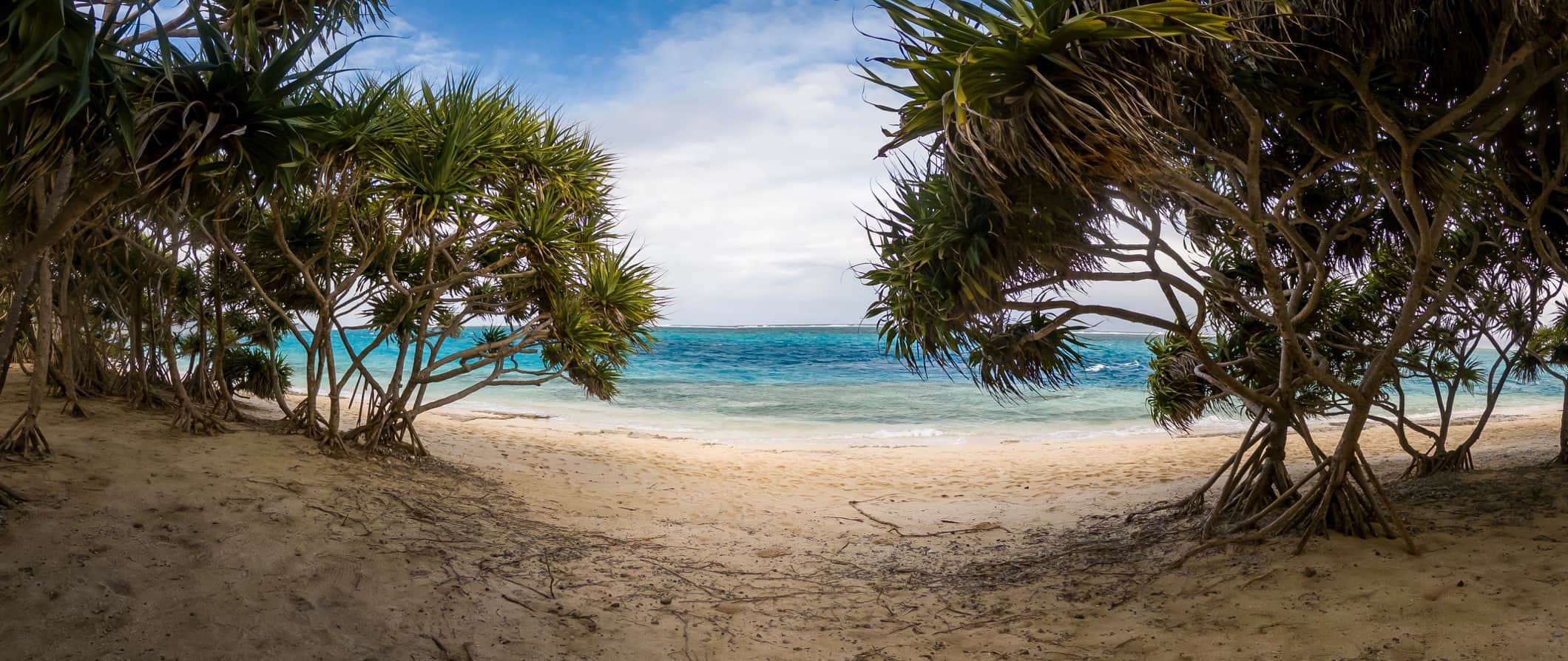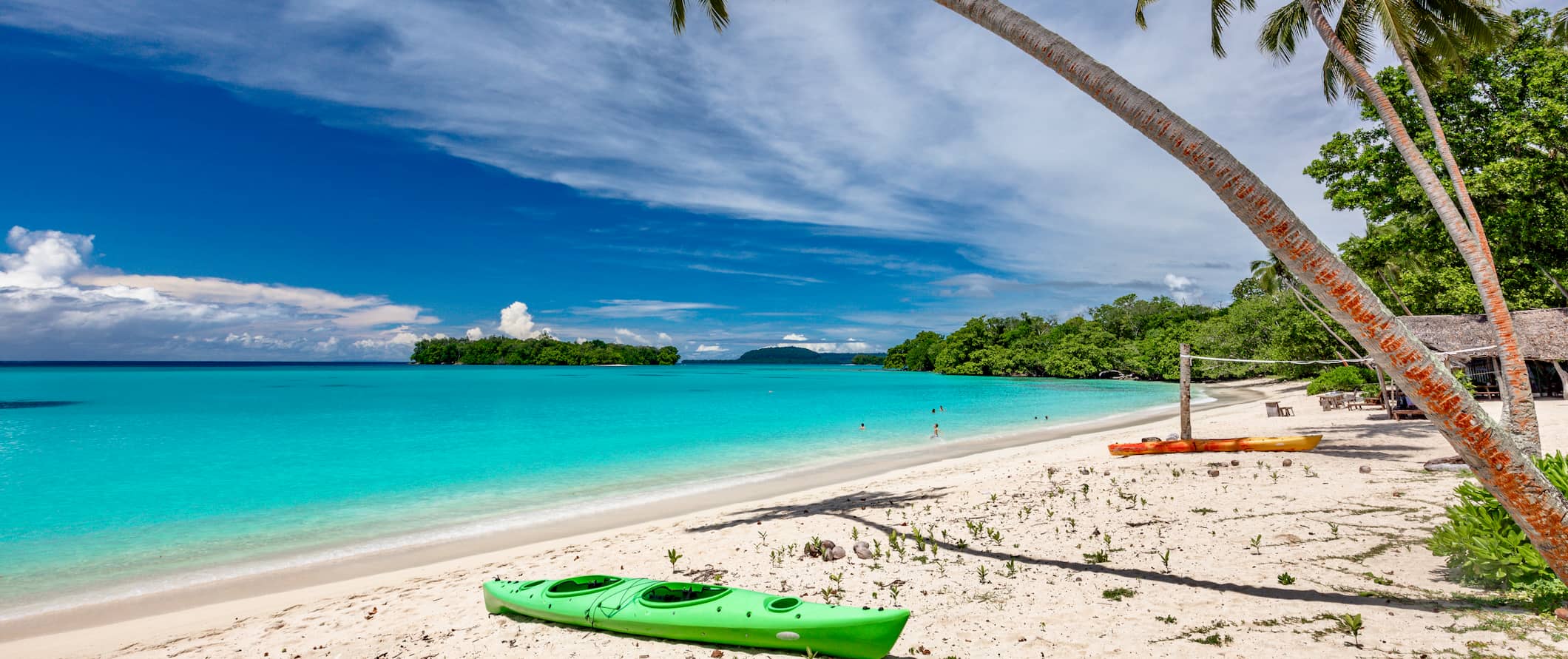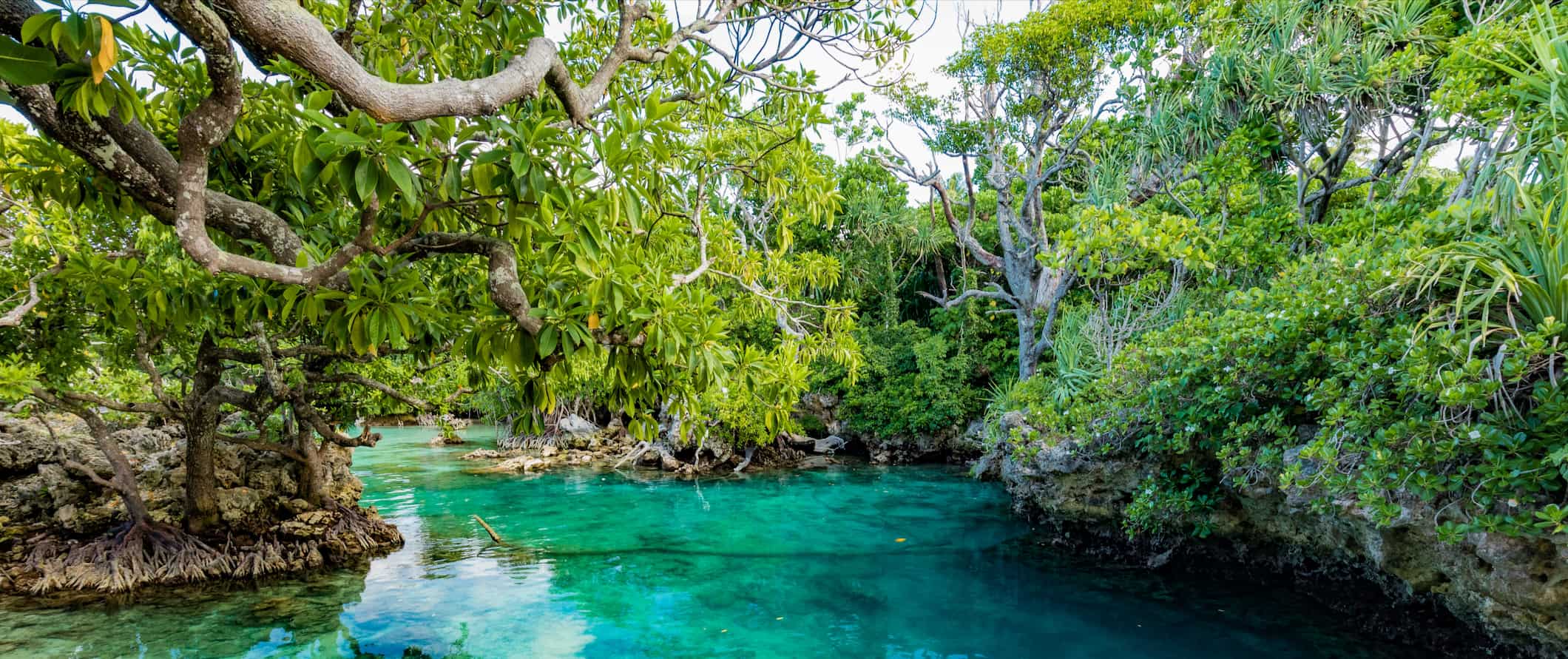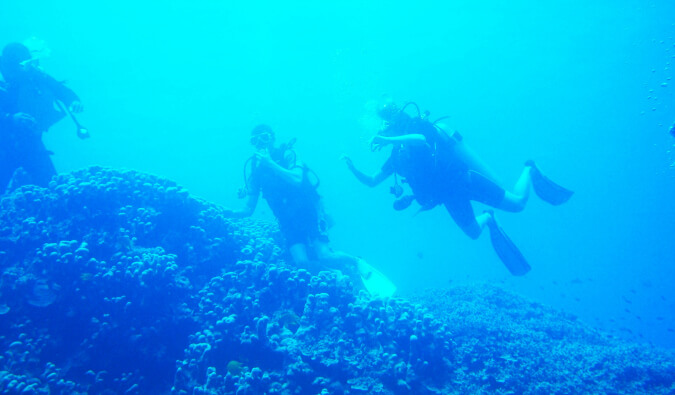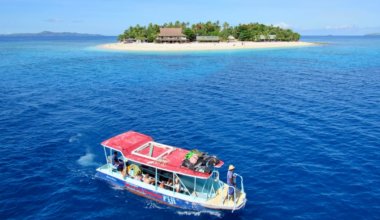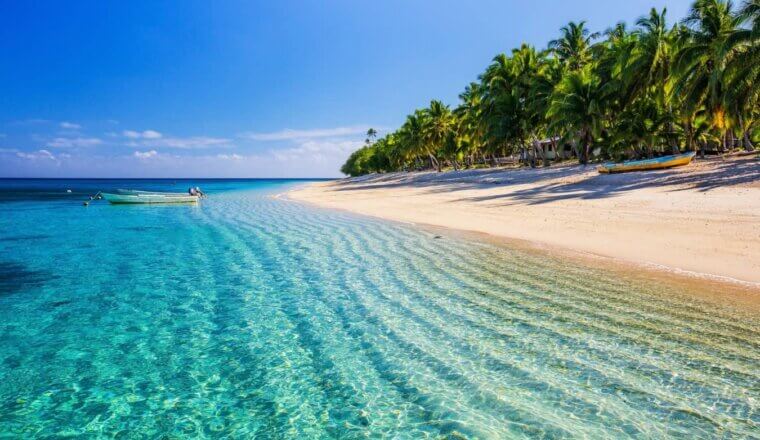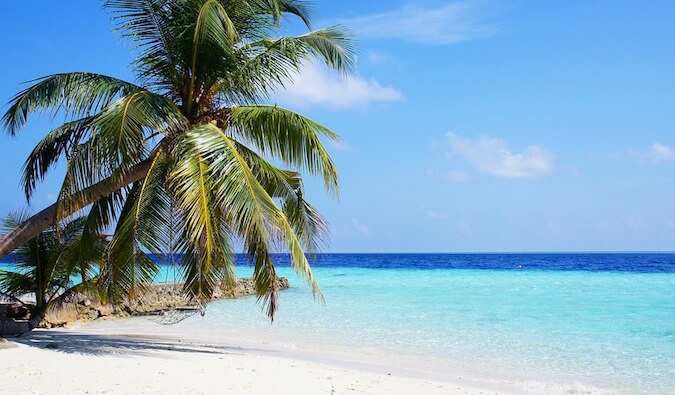The archipelago of Vanuatu is made up of 83 islands that offer fantastic tropical views, vivid landscapes, lush rainforests, world-class diving, lots of fish, and unforgettable Pacific hospitality.
A lot of people visit Vanuatu when they are in New Zealand since the flight time is short and there are the most connections.
Prices in Vanuatu are lower than other Pacific islands as it’s not yet a “hotspot” to visit. But just because tons of people don’t come here doesn’t mean it isn’t paradise. In fact, it’s probably even more of a paradise because of the fewer people!
Come here for friendly locals, lush jungles, unspoiled beaches, and great seafood. It’s a beautiful place to disconnect and relax.
This travel guide to Vanuatu helps you plan your trip, save money, and make the most of your visit to this tropical paradise!
Table of Contents
Top 5 Things to See and Do in Vanuatu
1. Go diving
There is amazing diving in Vanuatu, with underwater tunnels, caves, and grottoes to explore. There are tons of turtles, sharks, and rays in the waters here, there are pristine soft and hard corals, the water is warm, and the visibility is out of this world. If you’re lucky you might also see dolphins on the way to or from your dive. Don’t miss the SS “President Coolidge” wreck, which sank after running into mines during World War II. Single-tank dives cost around 8,500 VUV but many places only do two-tank trips.
2. See Mount Yasur
This is the world’s most accessible active volcano (and, indeed, one of the world’s most active volcanoes), where visitors can get up close to the caldera and watch it erupt (they’re small eruptions, nothing to worry about). Access is via a short rutted road that can be either driven in a 4WD or hiked (most people go by car). You can even camp around the volcano if you’re feeling extra daring. The hike to the top takes under an hour. Ask your accommodation to help you book a tour if you want to go by car.
3. Take a village tour
The tours of the tribal villages are educational and shed light on the people who call Vanuatu home. Ekasup Cultural Village is the best-known tour but there are options on all of the three main islands and on some of the other islands too. Some take you via minivan while others are done by bike. Prices vary but expect to spend at least 4,000 VUV for a day tour.
4. Explore Port Vila
Here, you can see evidence of the shared colonial influence of France and Britain. The food seems to be French-influenced while the language is a Pidgin English called Bislama. Along the main street, you can find duty-free stores and local shops selling artisanal crafts and there are some decent restaurants and bars here too. If you’re in town for a while, pay a visit to the National Museum, head to the outdoor market, head to the Summit to explore the Secret (botanic) Gardens, and go snorkeling just off the coast at Hideaway Island (1,250 VUV entry).
5. Visit Mystery Island
This tiny island is just 1 kilometer long (0.6 miles) and 200 meters (656 feet) wide. It’s largely uninhabited, save for travelers who fly or cruise here to explore its golden beaches, hike its remote jungles, and snorkel in its crystalline waters. As well as snorkeling it’s great for other water sports like kayaking and stand-up paddle boarding. You can take a few boat tours that operate here but they’re mostly limited to glass-bottomed boats and deep-sea fishing. If you’d rather stay on dry land, check out the beach markets or go get a massage. Flights from Port Vila take around 3 hours as you have to go via Tanna.
Other Things to See and Do in Vanuatu
1. Hike to the Mele Cascades
These waterfalls are some of the most famous in the whole country. They are easy to get to and the surrounding area has lots of hiking opportunities. They’re just 10 kilometers (6 miles) from Port Vila and the hike to them takes 2-3 hours. Admission is 2,000 VUV so pack a lunch and make an afternoon of it to get your money’s worth.
2. Visit Chief Roi Mata’s Domain
This UNESCO World Heritage Site is half an hour’s drive north of Port Vila. Mata was a 12th-century ruler who was poisoned by his brother. The area of northwest Efate and the islands of Lelepa and Artok represent the Chief’s historic area of influence. The region has several archeological sites you can visit. You can see where the chief lived, where he is buried, and where he was killed. Don’t miss the National Museum and Cultural Center to learn about the region’s history and culture before heading off to the Northwest of Efate to check out the domain.
3. Explore the islands
Rent a kayak or sailboat, or head out on an organized boat tour around the islands. Kayaking tours take you to a small coral island, which is stunningly beautiful. A full-day kayak or SUP rental is around 3,000 VUV while a guided tour costs 6,000 VUV. Boat tours start at 7,500 VUV.
4. Enjoy some water sports
Whether it’s kitesurfing, surfing, or parasailing, you can find something on the beach to keep you active or get your heart pounding. Prices vary depending on the activity so ask your accommodation to help you book lessons or gear or tours. Erakor Point, Port Resolution, and Pango Point are some popular spots for surfing.
5. Soak in the hot springs
In the northeast of Efate about an hour’s drive from Port Vila are the Nasinu Hot Springs. A local family runs the thermal springs and they are relatively basic and undeveloped (don’t expect any modern or fancy facilities). There are thermal pools and a mud bath, both of which claim to offer healing properties. There’s a restaurant nearby too.
6. Go fishing
Fishing is a popular pastime (and job) in Vanuatu and there are many competitions held throughout the year. A lot of companies offer deep-sea fishing trips for swordfish, marlin, Dorado, and Wahoo. Prices vary depending on how long you go for but expect to pay at least 100,000 VUV for a charter (they’re best shared between a group to split the cost).
7. Visit the underwater post office
Just 49 meters (160 feet) off the coast of Mele is a fully-functional underwater post office. What started as a funny idea over drinks by the local Postmaster eventually became a reality in 2003. You can only access the post office by diving to the ocean floor — and the post box is only open at certain hours. On land, you can purchase an embossed waterproof postcard that you can drop off in the underwater post box. To this day, it’s one of the only places in the world you can send mail underwater!
8. Watch naghol
On Pentecost Island, you can watch this performance of early bungee-jumping techniques in traditional naghol ceremonies. Vines are used to tie the legs together as jumpers leap from a 30-meter (98-foot) platform. Held on Saturdays between April and June, admission is 10,000 VUV.
Vanuatu Travel Costs
Accommodation – Hostels with dorms are in short supply so budget-conscious travelers should look for affordable guesthouses. Expect prices to start artounf 3,000 VUV per night. Most include free Wi-Fi and free breakfast. Those that don’t offer breakfast usually have kitchens.
Airbnb is available around the islands with private rooms starting at 2,100 VUV per night, however, most prices average triple that. For an entire home or apartment, prices start at 3,000 VUV per night.
For those traveling with a tent, wild camping is prohibited and there are no campgrounds here. To pitch your tent, you need permission from the landowner. For that reason, camping isn’t recommended here.
Food – Vanuatuan cuisine is based heavily on fish, root vegetables like yam and taro, coconuts, and fresh fruit. Mangoes, plantain, pineapples, and papayas are all readily available. Be sure to try lap lap, (baked yam pudding) and simboro (a steamed roll wrapped in banana leaf). Tuna, Red Emperor, Parrotfish, Cod, and lobster are all common seafood staples.
Be sure to try kava, a traditional psychoactive non-alcoholic drink that’s extremely popular. It used to be consumed only at ceremonies and festivals but is now a common drink for all social situations. It has a mild narcotic effect and is quite relaxing, so it’s usually consumed at dusk.
For a meal of traditional cuisine, expect to pay 1,500 VUV. For a pizza, prices start at 1,300 VUV while Thai or Vietnamese food (which can only be found around Port Vila) costs around 1,700-2,000 VUV.
A three-course meal of traditional cuisine costs 3,250 VUV. A cappuccino costs 385 VUV, a beer costs 450 VUV, and a bottle of water costs 100 VUV.
For a week’s worth of basic groceries including staples like fish, seasonal produce, and rice, expect to pay at least 10,000 VUV. Eliminating expensive imported products such as cheese, chicken and beef can help you to keep these costs down.
Backpacking Vanuatu Suggested Budgets
On a backpacker budget of 11,000 VUV per day, you can stay in a budget guesthouse or a private room on Airbnb, cook most of your meals and have the occasional meal out, limit your drinking, do cheap activities like hiking and snorkeling, and use local transportation to get around.
On a mid-range budget of 26,000 VUV per day, you can stay in a private Airbnb apartment, eat out for all your meals, go diving, take some taxis to get around, enjoy a few drinks, and do some water sports like kayaking.
On a “luxury” budget of 48,000 VUV per day, you can stay in a hotel, rent a car to get around, visit other islands, take guided tours, eat out at any restaurant you want, and enjoy all the water sports and excursions that you want! This is just the ground floor for luxury though. The sky is the limit!
Vanuatu Travel Guide: Money-Saving Tips
Vanuatu may not be as expensive as other nearby islands but it’s not super cheap either. Fortunately, there are a few things you can do to save money in Vanuatu:
- Bring your own snorkeling gear – If you’re going to snorkel more than once or twice, bring your own gear. Rental prices can add up and the budget rental gear here is usually in poor condition.
- Avoid the resorts – The resorts here overcharge for everything. Avoid them!
- Cook your own meals – Stay somewhere with a kitchen to save money on food costs. It won’t be as glamorous as eating out, but it cuts your food costs significantly.
- Stay somewhere with free breakfast – Many budget hotels include free breakfast. Stay at one of them to lower your daily food expenses.
- Bring a reusable water bottle – The tap water here is safe to drink so bring a reusable water bottle to save money and lower your single-use plastic consumption. LifeStraw makes a reusable bottle with a filter so you can ensure your water is clean and safe.
Where to Stay in Vanuatu
There are virtually no hostels in Vanuatu so budget travelers need to rely on affordable guesthouses and hotels as their main accommodation choice. Here are a few suggestions to help you get started and save money:
- Bluepango (Port Vila)
- Travellers Budget Motel (Port Vila)
- Retreat Seaside (Port Vila)
- Volcano Island Paradise Bungalows (Tanna)
How to Get Around Vanuatu
Ferry – Ferries are available between the main islands, though they don’t operate often (some only go once per week) and they can take several hours. Expect to pay between 5,000-10,000 VUV for a one-way ferry ride. There are also some smaller boats that operate called banana boats. Head to the port to find out the most recent timetable and fares.
For destinations further afield, such as Luganville, the 25-hour ferry costs around 10,000 VUV.
Bus – The bus system here has no fixed routes but you can usually catch one along one of the main roads. There aren’t always bus stops, particularly outside of the towns, so simply wave down a bus, hop on, and tell them when to stop. There are buses around Efate and along the east coast of Espiritu Santo. Expect to pay around 150 VUV for short journeys and 200-500 VUV for longer ones.
Taxi – Taxis in Vanuatu charge around 100 VUV per kilometer, although it can be more if the road conditions are bad! If you’re traveling from the airport to downtown Port Vila, it’s a flat fee of 1,400 VUV.
Flying – Efate, Santo, and Tanna can be reached via relatively affordable flights. Expect to pay around 16,000 VUV for the one-hour flight from Efate to Santo. The one-hour flight from Efate to Tanna costs about the same.
For the smaller islands, most of the airports have grass landing strips and are little more than fields. Some don’t even have electricity and most have no other facilities there. Expect smaller planes and more expensive flights.
Car rental – If you want to explore the main island by car, rentals start at 6,500 VUV per day. An International Driving Permit (IDP) isn’t required to rent a car here. Drivers typically need to be 23 years old and have had their license for at least one year.
For the best car rental prices, use Discover Cars.
Hitchhiking – Hitchhiking in Vanuatu is hard. There isn’t a lot of traffic here so expect long waits. However, the locals are friendly and usually don’t mind picking people up. Hitchwiki is your best resource for additional information.
When to Go to Vanuatu
April to October is the most popular time to visit Vanuatu. This is when temperatures are a comfortable 18-28°C (65-82°F).
November to March is the wet season, however, showers are usually brief and there is still plenty of sunshine. There are fewer crowds and slightly cheaper prices during this period as well.
May-June and September-October are the shoulder season and offer the best balance of price and weather.
The water in Vanuatu is a mild 22-28°C (72-82°F) all year round so you can really enjoy this island paradise any time.
How to Stay Safe in Vanuatu
Vanuatu is very safe and violent crime against visitors is rare. Petty theft is the most common issue, so keep your valuables secured and out of sight to avoid trouble. Always lock your accommodation and keep any valuables stored in a safe if possible. Most crimes are crimes of opportunity so as long as you take precautions you should be fine.
Solo female travelers should generally feel safe here, however, the standard precautions apply (never leave your drink unattended at the bar, never walk home alone intoxicated, etc.).
Scams here are rare, but if you’re worried about getting ripped off you can read about common travel scams to avoid here
November-April is cyclone season. Be prepared for potential flooding and landslides. Earthquakes are also common in this region of the world, so always make sure you’re familiar with your accommodation’s emergency exits. While unlikely, it’s always better to be safe than sorry.
Since the country has more conservative social values, avoid wearing clothing that is too revealing.
Tropical diseases like Dengue fever and malaria are possible (especially in the rainy season). Make sure you have a vaccination for Dengue and seek medical advice about your options for malaria before arriving.
If you experience an emergency, dial 112 for assistance.
The most important piece of advice I can offer is to purchase good travel insurance. Travel insurance protects you against illness, injury, theft, and cancellations. It’s comprehensive protection in case anything goes wrong. I never go on a trip without it as I’ve had to use it many times in the past. You can use the widget below to find the policy right for you:
Vanuatu Travel Guide: The Best Booking Resources
These are my favorite companies to use when I travel. They consistently have the best deals, offer world-class customer service and great value, and overall, are better than their competitors. They are the companies I use the most and are always the starting point in my search for travel deals.
- Skyscanner – Skyscanner is my favorite flight search engine. They search small websites and budget airlines that larger search sites tend to miss. They are hands down the number one place to start.
- Hostelworld – This is the best hostel accommodation site out there with the largest inventory, best search interface, and widest availability.
- Booking.com – The best all around booking site that constantly provides the cheapest and lowest rates. They have the widest selection of budget accommodation. In all my tests, they’ve always had the cheapest rates out of all the booking websites.
- Get Your Guide – Get Your Guide is a huge online marketplace for tours and excursions. They have tons of tour options available in cities all around the world, including everything from cooking classes, walking tours, street art lessons, and more!
- SafetyWing – Safety Wing offers convenient and affordable plans tailored to digital nomads and long-term travelers. They have cheap monthly plans, great customer service, and an easy-to-use claims process that makes it perfect for those on the road.
- LifeStraw – My go-to company for reusable water bottles with built-in filters so you can ensure your drinking water is always clean and safe.
- Unbound Merino – They make lightweight, durable, easy-to-clean travel clothing.
- Top Travel Credit Cards – Points are the best way to cut down travel expenses. Here’s my favorite point earning credit cards so you can get free travel!
Vanuatu Travel Guide: Related Articles
Want more info? Check out all the articles I’ve written on South Pacific travel and continue planning your trip:
